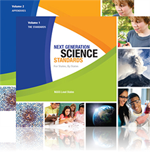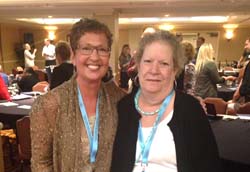How Can Elementary Teachers Work Toward the Vision of the Next Generation Science Standards?
By Guest Blogger
Posted on 2014-09-09
 When I taught elementary school, science was the foundation around which I built my multi-age classroom, but I think this approach was rare. With the release of the Next Generation Science Standards (NGSS), we have the opportunity for science to become front and center in more elementary classrooms. I am thrilled about the NGSS and the promise and opportunity it holds for ALL students. I am also relieved because finally someone out there “gets it”—just look at Practices # 6 (constructing explanations and designing solutions) and #8 (obtaining, evaluating and communicating information). Science can be the basis of rich instruction around where reading, writing, speaking, and listening are learned and practiced! We don’t have to teach only mathematics and language arts to make students better readers and writers.
When I taught elementary school, science was the foundation around which I built my multi-age classroom, but I think this approach was rare. With the release of the Next Generation Science Standards (NGSS), we have the opportunity for science to become front and center in more elementary classrooms. I am thrilled about the NGSS and the promise and opportunity it holds for ALL students. I am also relieved because finally someone out there “gets it”—just look at Practices # 6 (constructing explanations and designing solutions) and #8 (obtaining, evaluating and communicating information). Science can be the basis of rich instruction around where reading, writing, speaking, and listening are learned and practiced! We don’t have to teach only mathematics and language arts to make students better readers and writers.
 For K–5 teachers, the thought of implementing the NGSS in classrooms can be overwhelming. But, it’s exciting too! The NGSS gives us opportunities that we’ve not had in the past to finally make science the centerpiece of the elementary classroom. I think we can make this transition to NGSS more easily if we have a deeper understanding of the NGSS content we need to use in our science instruction. Most (many) elementary teachers, including me, did not learn much science in college, so whenever a learning opportunity presents itself, I am usually the first to sign up. One of those opportunities is coming up soon. NSTA is sponsoring a series of web seminars specifically designed for elementary teachers by people who know elementary teachers best—me, a former elementary teacher turned state science coordinator five years ago; Dr. Mary Starr, author, Executive Director of the Michigan Mathematics and Science Centers Network, and a science consultant who has been working with elementary teachers; and Dr. Carla Zembal-Saul, author of What’s Your Evidence?: Engaging K–5 Children in Constructing Explanations in Science, and a teacher educator who focuses on elementary science and strives to create strong connections between research and practice.
For K–5 teachers, the thought of implementing the NGSS in classrooms can be overwhelming. But, it’s exciting too! The NGSS gives us opportunities that we’ve not had in the past to finally make science the centerpiece of the elementary classroom. I think we can make this transition to NGSS more easily if we have a deeper understanding of the NGSS content we need to use in our science instruction. Most (many) elementary teachers, including me, did not learn much science in college, so whenever a learning opportunity presents itself, I am usually the first to sign up. One of those opportunities is coming up soon. NSTA is sponsoring a series of web seminars specifically designed for elementary teachers by people who know elementary teachers best—me, a former elementary teacher turned state science coordinator five years ago; Dr. Mary Starr, author, Executive Director of the Michigan Mathematics and Science Centers Network, and a science consultant who has been working with elementary teachers; and Dr. Carla Zembal-Saul, author of What’s Your Evidence?: Engaging K–5 Children in Constructing Explanations in Science, and a teacher educator who focuses on elementary science and strives to create strong connections between research and practice.
Working in collaboration with these two educators to prepare these web seminars has been a unique learning experience. My own understanding of the NGSS has grown as we have grappled with how to best share our ideas with you within the limitations of the medium. I am looking forward to learning more from you as we move forward with these professional learning experiences. Our vision is that the series of web seminars will encourage teachers to come together in a professional learning community that will be nourished by discussions in the NSTA Learning Center forums.
 When choosing the content for each of the grade level web seminars we thought about the following things: first and foremost, the standards; second, what teachers are already doing well in the classroom; and third, new information we have discerned that teachers need, based on actual questions they have asked us. Content alone does not make up the Next Generation Science Standards and this approach is very different from standards in the past. Visualize the NGSS as a rope with three strands: disciplinary core ideas, crosscutting concepts, and science and engineering practices. Each strand gets its strength from being interwoven with the other two—they are not meant to stand alone. With that in mind, although the disciplinary core idea might be grade-specific, the practices and crosscutting concepts are not. All of the web seminars will discuss and/or demonstrate the use of the practices and crosscutting concepts in the classroom. Different practices will be highlighted in various web seminars so even if you teach third grade, for instance, it might make sense for you to attend the whole series. We would love to have you!
When choosing the content for each of the grade level web seminars we thought about the following things: first and foremost, the standards; second, what teachers are already doing well in the classroom; and third, new information we have discerned that teachers need, based on actual questions they have asked us. Content alone does not make up the Next Generation Science Standards and this approach is very different from standards in the past. Visualize the NGSS as a rope with three strands: disciplinary core ideas, crosscutting concepts, and science and engineering practices. Each strand gets its strength from being interwoven with the other two—they are not meant to stand alone. With that in mind, although the disciplinary core idea might be grade-specific, the practices and crosscutting concepts are not. All of the web seminars will discuss and/or demonstrate the use of the practices and crosscutting concepts in the classroom. Different practices will be highlighted in various web seminars so even if you teach third grade, for instance, it might make sense for you to attend the whole series. We would love to have you!
Series Description
September 17, 2014: Kindergarten
In the NGSS, there are four performance expectations bundled together under the topic of weather. We have chosen to address the classroom instruction that is needed to help students meet the performance expectation, Use and share observations of local weather conditions to describe patterns over time, by the time they leave kindergarten. What does everyday instruction around this weather look like?
October 22, 2014: First Grade
Waves are introduced in first grade in the topics of both light and sound. We will highlight the instruction students will need in order to plan and conduct investigations to determine the effect of placing objects made with different materials in the path of a beam of light. We will use videos of actual classrooms to demonstrate that first graders can do very cool science. Using video examples, participants will be able to visualize the first graders in their school doing science around waves.
November 19, 2014: Second Grade
Understanding the concept of matter is foundational to the majority of the science instruction that occurs in later grades. Science instruction in second grade is one of the large building blocks. In this web seminar we will focus on what students need to know and be able to do to construct an argument with evidence that some changes caused by heating and cooling can be reversed and some cannot. What instruction is needed for the students to be successful with this performance expectation by the end of the year? We hope participants will feel more prepared to plan instruction around this concept.
December 17, 2014: Third Grade
Students need the opportunity to explore inheritance and variation and by the end of the third grade, be able to analyze and interpret data to provide evidence plants and animals have traits inherited from parents and that variation of these traits exists in a group of similar organisms. What learning experiences can we provide to students to move them towards this goal? How can we help students build this understanding? What might you do? By joining us in this web seminar, participants will get the answers to some of these questions.
January 21, 2015: Fourth Grade
Students will come into fourth grade with many different ideas and understandings about energy. We will focus on energy transfer and transformation. By the end of fourth grade, students need to make observations to provide evidence that energy can be transferred from place to place by sound, light, heat, and electric currents. In this web seminar we will share examples of what it might look like in the classroom. We will answer questions we have heard from many teachers about teaching this concept and address questions from webinar participants.
February 18, 2015: Fifth Grade
In this web seminar we will look at what needs to happen in the classroom during this unit so that students are able to understand Matter and Energy in Organisms and Ecosystems the way that it was envisioned in the NGSS. By the end of the year, the students are expected to develop a model to describe the movement of matter among plants, animals, decomposers, and the environment. How might students meet this expectation using their own environment? We will help participants explore the interdependent relationships and how they can lead to greater student understanding.
I have learned so much by using NSTA resources, including many in the Learning Center. There are not many web seminars I have missed, especially those on the topic of the Next Generation Science Standards. I’ve also used SciPacks when I had plenty of time to plan a science unit, and SciObjects when I needed “just in time” content knowledge to teach a lesson the following day. (Note, NSTA will release a SciPack on NGSS later this fall.) My favorite resource is the NSTA Community Forums where the conversation happens, and where I can ask my own questions or share my ideas. I am hoping to talk with many people in the Forums following each of the web seminars.
See you on September 17th.
Editor’s Note
To register for the upcoming web seminars, go to (http://learningcenter.nsta.org/products/symposia_seminars/NGSS/webseminar.aspx. Visit the NGSS@NSTA Hub to access NSTA’s growing collection of NGSS resources. To access the official NGSS website, go to www.nextgenscience.org.
 Today’s Guest Blogger is Kathy Renfrew
Today’s Guest Blogger is Kathy Renfrew
Kathy Renfrew is the K-5 science Coordinator for the Vermont Agency of Education, as well as an NGSS@NSTA curator and online advisor in the NSTA Learning Center. Kathy is an advocate for quality science instruction in elementary classrooms and working with teacher leaders as Vermont transitions to NGSS.” Email her at Kathy.Renfrew@state.vt.us or follow her on Twitter at @KRScienceLady.
(Photo: Kathy Renfrew, right; Carla Zembal-Saul, left)
Follow NSTA
| |
|
|
|
Disclaimer: The views expressed in this blog post are those of the author(s) and do not necessarily reflect the official position of the National Science Teaching Association (NSTA).


